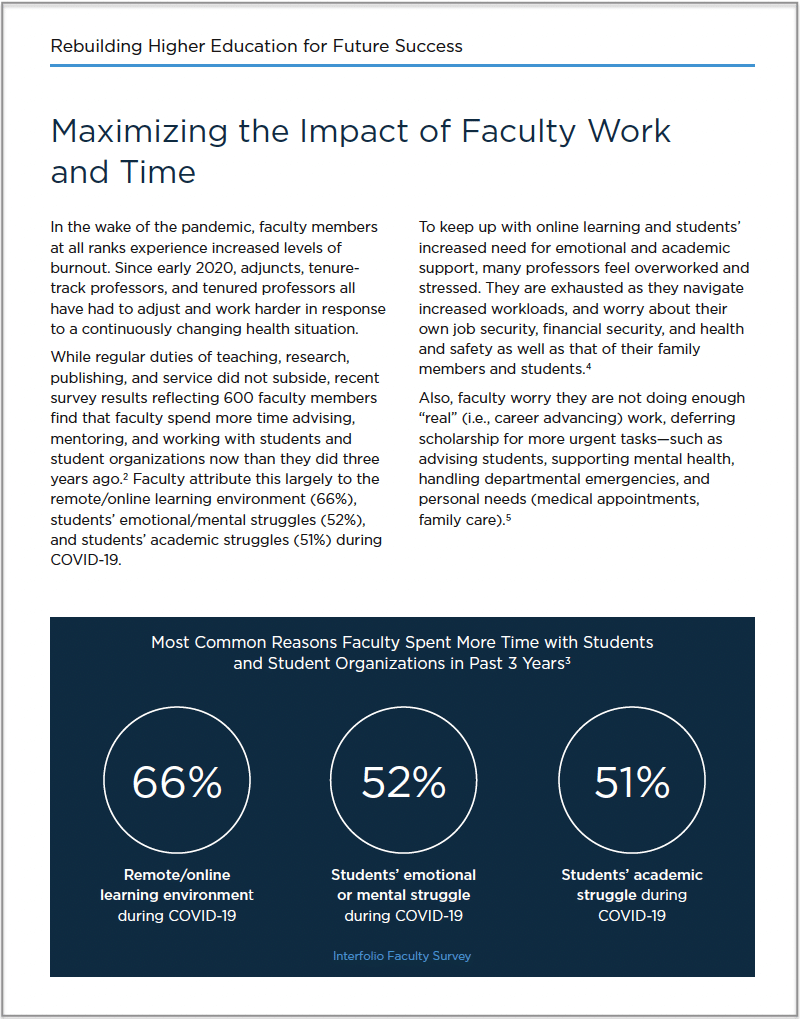A recent survey conducted by Interfolio and Hanover Research of over 600 faculty members from higher education institutions across the country provides a revealing snapshot of faculty’s feelings regarding their workloads, career journeys, and faculty technology. As part of a three-part series looking at the survey results, this blog article details survey insights into faculty career journeys.
Your faculty may be exhausted by their heavy workloads during the pandemic and anxious about their career paths, but there’s good news.
You can give them significant time back to re-invest in the work that is most meaningful to them with one step.
This step can complement larger systematic changes that you are tackling, such as how to reflect COVID challenges in reviews and promotions, how to prioritize equity and inclusion among your faculty and institution, and more.
The transformation your institution can take now is adopting a faculty information system. And with a modular approach, you can prioritize the most pressing needs of your faculty, and build from there. With a technology purpose built for faculty and shared governance, you will achieve immediate — and long-term — benefits for your faculty and institution.
Why Your Faculty Want Faculty Technology
Most faculty (81%) believe that a faculty information and workflow technology designed specifically for faculty would be very helpful in their career success – according to our survey of over 600 faculty members in higher education.
That means that if you implement or expand faculty management technology at your institution, you can give your faculty some peace of mind about their careers, which would be especially welcome given the pandemic disruptions to their careers.
Technology that is purpose-built for the faculty lifecycle is reassuring to faculty for a number of reasons.
First, these software solutions save time, replacing administrative busywork faculty must carry out with efficient, digital processes. In contrast to home-grown systems in which faculty have to hunt for files across different sites or folders, a faculty information system gives faculty a centralized location from which they can view and comment on files. With the time such a system saves, faculty can focus on the things that are most important to their careers, whether that is research, student support, or creative projects.
While there may be additional steps institutions must take to further improve faculty work-life balance, preventing wasted time is an important first step.
Second, a faculty information platform promotes transparency in faculty review, promotion, and tenure. In particular, such a platform makes advancement requirements clear to faculty and their review committees while also documenting each review, creating a record for the future.
When you enable faculty to clearly see the path they need to take for career success, you eliminate some of the stress inherent in these important career milestones. That is, faculty can focus on preparing their work for presentation in the review process, rather than stressing about obtaining files on a shared drive or who to send those files or even what actual files are needed for a particular review.
Likewise, when faculty know that all reviews are documented, they have reassurance that there is a strong check in place against inappropriate, unethical, or illegal decisions.
How Faculty Technology Supports Equity Goals
Another benefit of faculty technology is that it helps you pursue your goals for a diverse faculty and equitable hiring and retention practices.
Achieving equity in your faculty is not just a mandate if you’re to live your institutional values; it’s good business.
How so? Research shows that female students and students of color feel better supported when there are same-gender and same-race faculty at their institution. Given that 59.5% of U.S. college students are women, if you want the majority of your students to feel supported, you need more female faculty.
Likewise, you can’t effectively attract and support students of color if you’re not hiring and promoting faculty members of color.
A Faculty Information System facilitates the attraction and retention of female and underrepresented faculty in several ways:
- Its documentation of hiring and promotion processes signals that your institution values transparency and guards against inequitable practices; that signal is likely to attract diverse faculty.
- Its data-collection capabilities during hiring and review enable institutions to assess their progress in hiring and retaining diverse faculty and to identify needed improvements.
- Its faculty-activity-reporting function enables faculty to easily capture a full range of their work, including service and activities relating to diversity, equity, and inclusion (DEI). In turn, this visibility allows the institution to more fully recognize where time is — or is not — being spent.
Of course, faculty technology alone can’t lead to a diverse faculty that is representative of either the student body or the wider community. Institutions must also be willing to recognize and reward DEI and student-support activities.
Likewise, institutions must equitably address the disproportionate effect of the pandemic on female and underrepresented faculty.
But faculty technology can make follow-through on these institutional choices easier.
White Paper: Rebuilding Higher Education
If you’d like to learn more about how institutions are pursuing these reforms, we recommend the white paper The Time is Now: Rebuilding Higher Education: How Faculty Affairs Professionals Can Lead their Institutions to Future Success.

